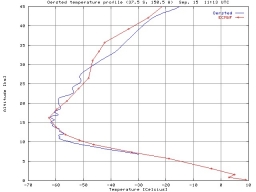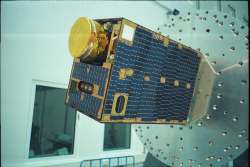| GSP Study Archive |
|---|
| Space Weather Studies |
| Applications Pilot Project |
| Feasibility Studies |
| CDF Space Weather Study |
| Past Workshops |
| Past Publications |
 GPS Validation
GPS Validation
Validation of Near-real-time GPS Occultation Data Products for Meteorological Services
Developer
DMI
Technical Groups
GIC & Ground Effects, Ionospheric Effects & Activity Forecast
SDA objective
The basic objectives for the project are the following:
- Identify and describe Space Weather conditions which can adversely affect the quality and reliability of atmospheric profiling data acquired through GPS occultation measurements.
- Define characteristics indicative of poor GPS data quality resulting from adverse space weather effects.
- Devise algorithms to validate GPS data products in an operating near-real-time end-to-end chain for processing of GPS data from telemetry to application
Products
GPS occultation data
Link to Project WebSite
SDA description
 The meteorological services all over the world are about to employ a new and revolutionary globe-spanning satellite-based system with the capability to furnish round-the-clock weather data by using signals transmitted from satellites of the existing US Global Positioning System (GPS), and/or the planned European navigational satellite system: Galileo. The satellites carrying the GPS receivers are Low Earth Orbiting (LEO) satellites like the Danish Oersted satellite. These satellites may probe the atmosphere using the occultation technique (limb sounding) where the changes in phase and amplitude of signals transmitted from the high-altitude GPS satellites are monitored as the signal path decends toward or rises from the horizon.
The meteorological services all over the world are about to employ a new and revolutionary globe-spanning satellite-based system with the capability to furnish round-the-clock weather data by using signals transmitted from satellites of the existing US Global Positioning System (GPS), and/or the planned European navigational satellite system: Galileo. The satellites carrying the GPS receivers are Low Earth Orbiting (LEO) satellites like the Danish Oersted satellite. These satellites may probe the atmosphere using the occultation technique (limb sounding) where the changes in phase and amplitude of signals transmitted from the high-altitude GPS satellites are monitored as the signal path decends toward or rises from the horizon.
 Such a sequence of paths brings the signal through a deep cross-section of the atmosphere. Variations in electron density, air density, temperature and moisture can change the amplitude and phase of the probing signals and bend their paths. Measuring and analyzing these signal changes enables the detection of the atmospheric conditions that produces them. The total sequence of signal samples received during a completed occultation event can, for instance, be inverted by Abel transform into vertical profiles for atmospheric electron content, density, temperature and moisture. An example is shown in the figure presenting a temperature profile from Oersted. The profile is compared to ECMWF analysis at approximately the same location (37 S, 151 W) and time (12:00 UTC).
Such a sequence of paths brings the signal through a deep cross-section of the atmosphere. Variations in electron density, air density, temperature and moisture can change the amplitude and phase of the probing signals and bend their paths. Measuring and analyzing these signal changes enables the detection of the atmospheric conditions that produces them. The total sequence of signal samples received during a completed occultation event can, for instance, be inverted by Abel transform into vertical profiles for atmospheric electron content, density, temperature and moisture. An example is shown in the figure presenting a temperature profile from Oersted. The profile is compared to ECMWF analysis at approximately the same location (37 S, 151 W) and time (12:00 UTC).
There are, however, some imperfections and uncertainties associated with this new technique. A basic problem is the variable quality of the individual atmospheric profiles derived from the GPS signals. The quality is affected, among other, of space weather-related conditions like strong or sudden development of horizontal irregularities in the ionospheric electron densities and the occurrence of signal scintillations associated with plasma instabilities and ionospheric current filamentation.
A further obstacle is the data availability. Usually, the occultation data are collected along the orbit and stored onboard the satellite for download during passes over a ground telemetry station. A LEO satellite, typically, has two or three passes separated by around 100 min (orbital period) within each of two daily sequences over a given receiving station. This limits the interval of availability of near-real-time data for each of the LEO satellites in question. Furthermore, special efforts are required to process the data fast enough to assimilate them into operational NWP models with specific requirements on data latency.
 The submitted proposal on “Validation of near-real-time GPS occultation data products for meteorological services” builds on the experiences gained in the field of satellite data analysis and GPS observations acquired at TERMA and DMI through, among other, managing the Ørsted satellite mission. Further it relies on the experiences gained at DMI in the field of Space Weather through its Solar-Terrestrial research activities and in the field of Meteorological services conducted through its 130 years existence to provide guidance to solve Space Weather-associated GPS application problems.
The submitted proposal on “Validation of near-real-time GPS occultation data products for meteorological services” builds on the experiences gained in the field of satellite data analysis and GPS observations acquired at TERMA and DMI through, among other, managing the Ørsted satellite mission. Further it relies on the experiences gained at DMI in the field of Space Weather through its Solar-Terrestrial research activities and in the field of Meteorological services conducted through its 130 years existence to provide guidance to solve Space Weather-associated GPS application problems.
The GPS radio occultation experiment on Ørsted provides information of the neutral atmosphere temperature, pressure and water vapor as well as the electron density in the ionosphere. Measurements are made with a space qualified GPS receiver, "Turbo-Rogue", designed and provided by JPL, NASA. The receiving antenna is seen as the white square in the upper part of the rightmost solar panel of the Oersted satellite.
The Turbo-Rogue on Ørsted is capable of measuring the L1 and L2 phases and pseudo-ranges at three different sampling rates: low rate (0.1 Hz), medium-rate (1 Hz) and high-rate (10 Hz). In low-rate the receiver can track up to eight satellites simultaneously and the data are primarily used for precise orbit determination. These observations can also be used for ionospheric monitoring with a coarse resolution. The medium-rate data is meant to be used for ionospheric sounding with better resolution. The high-rate data is for sounding of the neutral atmosphere where the receiver is tracking on two channels, one for the occulting satellite and one for a reference satellite used in the calibration of clock related errors.
Contact / Manager
Georg Bergeton Larsen, Ph. D
| Address: | Atmosphere Space Research Division Danish Meteorological Institute Lyngbyvej 100 DK-2100 Copenhagen |
| E-mail: | gbl@dmi.dk |
| Telephone: | +45 39 15 74 89 |
| Fax: | +45 39 15 74 60 |